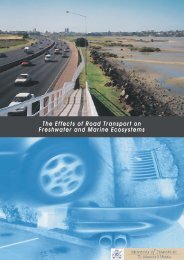Auckland City Centre Rail Link - Business Case Review - Ministry of ...
Auckland City Centre Rail Link - Business Case Review - Ministry of ...
Auckland City Centre Rail Link - Business Case Review - Ministry of ...
Create successful ePaper yourself
Turn your PDF publications into a flip-book with our unique Google optimized e-Paper software.
<strong>Auckland</strong> <strong>City</strong> <strong>Centre</strong> <strong>Rail</strong> <strong>Link</strong> <strong>Business</strong> <strong>Case</strong> <strong>Review</strong> | May 2011<br />
1.3 Purpose, origins and scope <strong>of</strong> the <strong>Business</strong> <strong>Case</strong><br />
Given existing congestion around the CBD and expectations <strong>of</strong> increased activity and<br />
employment within the CBD, the <strong>Business</strong> <strong>Case</strong> examined the benefits the project<br />
would provide by increasing passenger rail access to the CBD. The project is seen<br />
by <strong>Auckland</strong> Council as an important component <strong>of</strong> a package <strong>of</strong> measures required<br />
to support and promote growth in the productivity <strong>of</strong> the CBD and its social amenity,<br />
and as such to contribute to <strong>Auckland</strong>‘s growth as a whole.<br />
The background to the <strong>Business</strong> <strong>Case</strong> is important to understanding its timing and<br />
content.<br />
On 1 May 2008 the Minister <strong>of</strong> Finance under the previous government, wrote to the<br />
chair <strong>of</strong> NZ <strong>Rail</strong>ways Corporation (now part <strong>of</strong> Kiwi<strong>Rail</strong>) stating:<br />
“In my view it is in the long term public interest to secure and protect the CBD<br />
tunnel route, even though construction may not take place for many years...it is<br />
appropriate for ONTRACK to assist in the protection <strong>of</strong> the CBD tunnel route by<br />
acting to protect the route at the earliest appropriate opportunity”.<br />
This request was a response to the former <strong>Auckland</strong> <strong>City</strong> Council‘s granting <strong>of</strong> a nonnotified<br />
consent for a property development which could have compromised the<br />
future construction <strong>of</strong> the proposed tunnel. The route has no formal designation<br />
although it is mentioned in a range <strong>of</strong> planning documents.<br />
In June 2009, following an open procurement process between the <strong>Auckland</strong><br />
Regional Transport Authority (ARTA) and Kiwi<strong>Rail</strong>, Kiwi<strong>Rail</strong> gave approval for a<br />
contract to be signed with a consortium <strong>of</strong> Aecom, Parsons Brinckerh<strong>of</strong>f and Beca<br />
(APB&B) for the investigation and design <strong>of</strong> the CCRL. Kiwi<strong>Rail</strong> and ARTA shared<br />
the costs <strong>of</strong> the <strong>Business</strong> <strong>Case</strong> and the NZTA provided a 60 percent subsidy for<br />
ARTA‘s share <strong>of</strong> costs. The objective <strong>of</strong> the study was to ―produce Notice <strong>of</strong><br />
Requirement documentation <strong>of</strong> a quality sufficient to support designation <strong>of</strong> the<br />
route‖.<br />
Assessment <strong>of</strong> various CCRL route options and the number and locations <strong>of</strong> stations<br />
was undertaken from August 2009 to February 2010, when the preferred option was<br />
approved by ARTA and Kiwi<strong>Rail</strong> and endorsed by the former <strong>Auckland</strong> Regional<br />
Council, the <strong>Auckland</strong> <strong>City</strong> Council and the <strong>Auckland</strong> Regional Transport Committee.<br />
Subsequently in July 2010, following an initial business case stakeholder workshop 3<br />
in May, APB&B‘s brief for the <strong>Business</strong> <strong>Case</strong> was extended to undertake a review <strong>of</strong><br />
the CBD demographic trends and associated transport demands over the next 30<br />
years, together with an assessment <strong>of</strong> possible options for meeting these demands.<br />
The evolution and timing <strong>of</strong> the <strong>Business</strong> <strong>Case</strong>‘s development has meant that it does<br />
not contain some core elements set out in the NZTA‘s Economic Evaluation Manual<br />
(EEM) and the Treasury‘s <strong>Business</strong> <strong>Case</strong> guidelines (see www.infrastructure.govt.nz/<br />
publications/betterbusinesscases), which are requirements that need to be<br />
addressed before funding can be considered by the government. These most notably<br />
relate to the lack <strong>of</strong> a broad problem definition (the whole transport challenge facing<br />
the CBD) and the consequential full investigation <strong>of</strong> alternatives. This is not an area<br />
<strong>of</strong> disagreement between central government agencies and <strong>Auckland</strong> Council and<br />
<strong>Auckland</strong> Transport but reflects the changing pattern <strong>of</strong> expectations <strong>of</strong> this work<br />
3 The workshop was attended by representatives <strong>of</strong> the Treasury, the <strong>Ministry</strong> <strong>of</strong> Transport, and the NZTA as well as<br />
the former <strong>Auckland</strong> Regional and <strong>Auckland</strong> <strong>City</strong> Councils,<br />
10
















